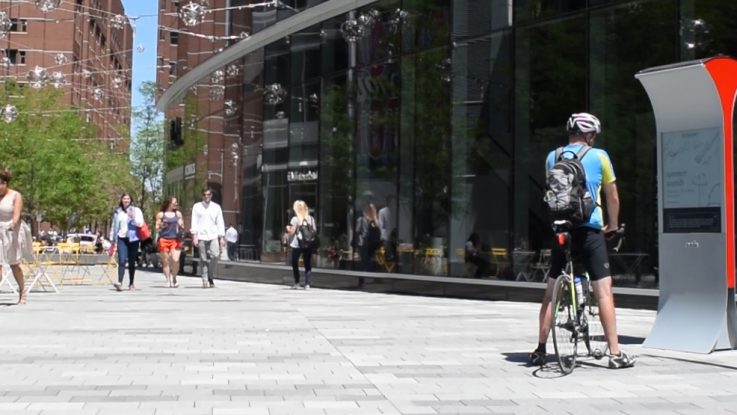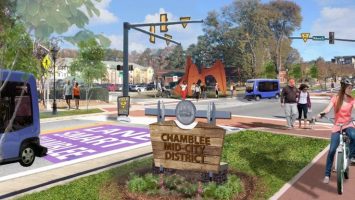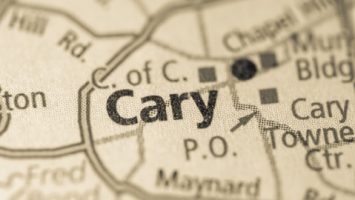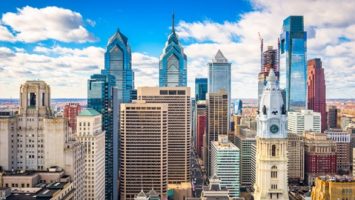
A sign that seamlessly and beautifully connects a city community? Soofa is making waves with theirs in over 100 cities. One project, out of the City of Atlanta, won a Smart 50 Award. We took time to speak with Edward Krafcik, who leads partnerships and business development at Soofa, about the project, winning the award, what it means to be “smart”.
LB: Tell me about your project and how you began working with Atlanta on the two-sign proof of concept, originally.
EK: The Soofa Sign is our second product at Soofa, our first being the Soofa Bench. We started Soofa in late 2014 out of the MIT Media Lab and, by 2017, we were working with over 100 cities globally. We deployed the Soofa Bench to downtown areas, neighborhoods, parks, and public plazas in cities big and small. When we launched the Soofa Sign — a product that was a direct response to what we learned from our city partners — we announced we were looking for early adopter cities with a need to improve public outdoor communication. The goal of the Soofa Sign early adopter program was for cities to more effectively, efficiently, and beautifully connect residents with each other, engage tourists and visitors, enabling them to fully experience the city and its neighborhoods, and connect their public-facing departments to people outside in the real world.
The City of Atlanta was one of 75 applicants and was selected based on their broad-reaching, yet extremely detailed and operationally sound proposal for how Soofa Signs would benefit the city and its diverse population in an equitable way.
LB: You were clearly able to provide the city with some hard data about the benefits of the Soofa sign, since they grew from two to 30 locations rapidly. Can you tell us about what that evidence looks like and how you show a city the value you offer?
EK: When we started the first phase of the Soofa Sign early adopter program with the City of Atlanta in early 2018 we had been working with SmartATL, the smart cities group within the city. One of the main goals SmartATL had, as did Soofa, for the pilot was to build a successful use case one department at a time, and then incrementally expand horizontally across City Hall in a measured way to create valuable use cases with multiple public-facing departments.
This meant that at the end of the first phase of the pilot project, success would be measured based on how many different departments were using the Soofa Sign network in a fully operational way to enhance their public communications strategy. Fully operational meaning that the Soofa Sign would become part of their staff’s daily workflow. The City of Atlanta Department of Customer Service (ATL311) quickly became a super user of the platform, regularly using the Soofa Sign network to reach people outside, offline in the neighborhoods they live in, work in, or visit for fun.
Paired with the rapid adoption of the Soofa Sign network as an extension of civic communication strategy, success and expansion potential was also determined based on citizen use and local business use of the platform.
We measure success specifically by:
- How many city departments use the Soofa Sign platform through Soofa Talk. This includes the number of accounts created and the number of posts generated. Thus far ATL311, the Department of Planning, and the Mayor’s Office of Communication have posted nearly 100 unique pieces of content to nine neighborhoods across Atlanta in the last nine months.
- The level of public engagement and public use of the platform as a neighborhood digital bulletin board. In the same way we study the use of Soofa Talk by the city, we also study the use of Soofa Talk by the public. In the same time period there have been hundreds of unique citizen accounts created, and thousands of posts launched to nine neighborhoods in the last nine months.
- The amount of sponsored content (how many of the free public posts are sponsored to increase their reach). The Soofa Sign network will ultimately be fully financed by local business advertising dollars, which we refer to as sponsored content.
LB: Tell me about a time when you approached a community of skeptics and saw them transition to believers. What was the “ah hah” moment or turning point?
EK: We work very closely with the communities where we install Soofa Signs, which means attending and presenting at neighborhood meetings, going door to door introducing ourselves to local businesses, and being on site for each and every sign installation to make sure we are able to have conversations with curious passersby. But this doesn’t always ensure everyone is going to be a believer and happy about a new technology like our signs right from the start.
As an example, the executive director of a local nonprofit in the Kirkwood neighborhood of Atlanta, was “feeling a little unsure about using Soofa signs in Atlanta for our volunteer-run nonprofit, the planet project, and our initiative hu-MAN Up.org. There seemed to be lots of skepticism in the community, but we decided to give it try, at the last minute, just a day before our recent documentary in our series, Movies that Matter in the Meadow which had been getting zero fresh faces. To our surprise, someone walked through our gate to see the film, claiming she learned about the event from the Soofa Sign – even though we had posted it on the neighborhood Facebook page 5 times. Folks [in the neighborhood will soon] realize that the signs have the potential to not only see what’s going on around town, but to create community.”
The “ah ha” moment where skeptics turn into believers is seeing for themselves the value the Soofa Sign provides. This can mean posting content to the sign and seeing some type of conversion — someone showing up at an event like the example above, someone scanning a QR code as a call to action, someone taking a photo of content on the sign and posting about it on social media — or it can even be the simple experience of walking by a sign, learning that it’s for public use, going online to Soofa Talk (www.soofatalk.com), creating a post, pushing go live, and then seeing that post appear in the real world.
LB: Why is it important to have democratized signage; and are there ways you feel, even now, that you would grow it to make it more equitable?
EK: Our vision for the Soofa Sign is to create the world’s first outdoor digital bulletin board, fully open for everyone to use, everywhere. A bulletin board is accessible — it lets everyone have a voice and if you think about where you see old-school, push pin bulletin boards, they are often in places like coffee shops, community centers, libraries, city hall atriums — places where the public comes together and has the opportunity to connect and share with each other. When we translate this idea into the public realm, neighborhood main streets and mixed use cores serve as community gathering places. These places exist in neighborhoods of all types and all sizes, regardless of demographic makeup. Having Soofa Signs strategically placed in locations that are at the core of neighborhoods gives people an opportunity to share, learn, and connect with even greater reach than an old-school, indoor push pin bulletin board.
As we continue to expand the network of Soofa Signs across Atlanta, we are working closely with the Department of Planning, specifically the placemaking and mobility teams who are focused on improving public transit ridership experience in under served neighborhoods and emerging communities.
One of the most important things for us as we think about what makes an “equitable deployment” is to remember that equity doesn’t only mean introducing a solution that is sustainable and valuable for under served or less served places and communities; it also means ensuring that a city-wide deployment is truly city-wide and addresses all populations. So, as we are working to make the installation more equitable, we’re focused on working with younger populations, older populations, neighbors with disabilities, neighbors whose first language isn’t English, and also places and communities that are filled with tourists and visitors to ensure that the Soofa Sign is truly equitable and capable of serving everyone.
LB: Since you began working with Soofa, what’s something you’ve learned along the way that you wish you knew or understood earlier? How would that have made a difference?
EK: I’ve actually been with Soofa since the very beginning. I was the first hire after our three co-founders, Sandra Richter, Jutta Friedrichs, and Nan Zhao spun Soofa out of the MIT Media Lab. When we launched the Soofa Bench in 2014, we quickly realized there was a use and a need for many departments across a single city.
As a startup with a product that was completely new to the market — no one else was making solar powered park benches at the time — it was exciting and encouraging to have so much demand from a diverse set of end users. However, what ended up happening is everyone wanted something a little different from the same product so there was always a risk that no one would actually get exactly the one thing they really wanted. We moved quickly and deployed with the belief that everything would just make sense for everyone after the product was installed.
While this isn’t unique to Soofa, it’s unfortunately a pretty rampant trend in the smart cities space. It’s why I’m still extremely skeptical of smart city pilots that are designed to be “evaluated by all departments” after they get installed. When every department is looking at different use cases from the same product, it can make the product feel like it’s highly valued, but in fact it can actually lead to inaction and inability to scale. We need to start from the beginning with a very well-defined use case for a single user, then incrementally expand from there to others.
We were fortunate to have worked with so many great cities prior to launching the Soofa Sign and learned a lot about how to navigate the process of trying to please all departments at once. This is why the sign is positioned as a digital neighborhood bulletin board that serves cities, citizens, and businesses as a real-time communication platform.
LB: Beyond the cool factor (because the signs are super cool!), cities need and want to communicate transparently with their residents. Have you seen any instances where your signs prompted better government-to-resident communication? Tell me about one of those moments where data produced a human-to-human result.
EK: Our work with ATL311 is always setting new precedents and best practices for outdoor public communication. This includes continued testing and refining of calls to action to drive community engagement. A great example is from a recent campaign they ran to get more people to download the ATL311 app. The content is simply a large QR code with a call to action to scan and download their app.
Shown for less than 1% of total airtime across the Atlanta Soofa Sign network for two weeks, the content converted 22 people to download the app. While the absolute number may seem small, the conversion rate is actually nearly 1%, comparable to conversion rates one expects to see online for digital marketing. In some ways this is validation that the Soofa Signs actually engage the public, but it’s also an exciting proof of performance that the content ATL311 is designing is being found useful by the public.
LB: You recently received a Smart 50 Award for this project. What does that mean to you?
EK: When we measure success of our Soofa Sign deployments, we always aim for positive feedback and approval from the public, who is ultimately the end user of our technology. We also work closely with our city partners to ensure the technology is doing what they expected it to and spend time co-developing further features or enhancing existing ones. However, receiving a Smart 50 Award is a completely different and is an extremely valuable form of validation and measure of success. It’s important for us as we continue to expand from city to city to receive validation from our peers, particularly around the notion that the positioning of the Soofa Sign as a digital community bulletin board for neighborhoods is exciting, logical, and perceived as valuable and impactful.
Even more important than what this means for Soofa as a validation that our work is resonating with the industry, we are very proud to be able to share this honor with the City of Atlanta. The leadership in the city is extremely forward thinking and willing to work together to build a solution that the public finds useful and demands more of.
Catch Soofa at Smart Cities Connect Conference and Expo in Denver this Spring!


